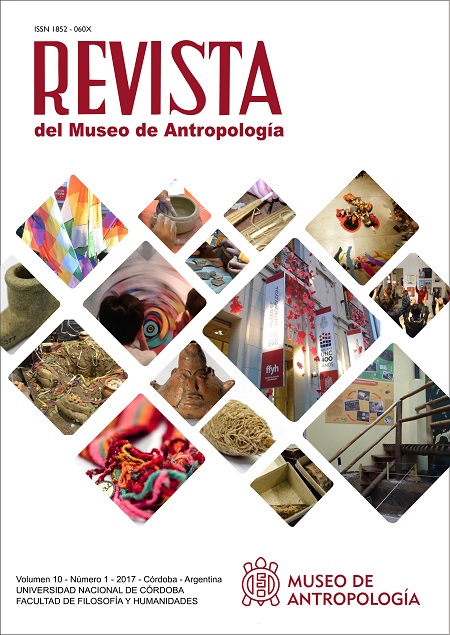The Abrigo Pozo Cavado site, Puna of Salta. New archaeological and chronological contributions to the study of processes of change from the end of the Middle Holocene (ca. 5600-4600 years BP)
DOI:
https://doi.org/10.31048/1852.4826.v10.n1.12735Keywords:
Middle Holocene, processes of change, Puna of SaltaAbstract
This paper analyzes and discusses new archaeological and chronological data at the end of the Middle Holocene (ca. 5600-4600 years BP) from the Abrigo Pozo Cavado site. This site is located in the Salar de Pocitos, Puna of Salta, at an altitude of 3700 masl. The archaeofaunal record presents an absolute predominance of Camelidae, yet variability in osteometric data indicates different species of this family. The lithic material has diverse morphologies of projectile points and raw materials, including allochthonous obsidian. Finally, the presence of shell beads is also reported.Downloads
References
Aldenderfer, M. 1998. Montane Foragers, Asana and the south- central Andean foragers. University of Iowa press. Iowa
Aschero, C. 1983. Ensayo para una clasificación morfológica de artefactos líticos aplicada a estudios tipológicos comparativos. Informe presentado al Consejo Nacional de Investigaciones Científicas y Técnicas (CONICET). Buenos Aires.
Aschero, C. 1994. Reflexiones desde el Arcaico Tardío (6000-3000 AP). Rumitacana. Revista de Antropología 1 (1): 13-17.
Cartajena, I, Núñez, L. y M. Grosjean. 2007. Camelid domestication on the western slope of the Puna de Atacama, northern Chile. Anthropozoologica 42 (2): 155-173.
Fernández, J. 1983 Río Grande. Exploración de un centro precerámico en las altas montañas de Jujuy, Argentina. Ampurias 45/46: 54-83.
Hocsman, S. 2006. Producción lítica, variabilidad y cambio en Antofagasta de la Sierra ca. 5500 –1500 AP. Tesis de doctoral. Facultad de Ciencias naturales y Museo, La Plata. Inédita.
Hoguin, R. 2014. Secuencia cronológica y tecnología lítica en la Puna Seca y Salada de los Andes Centro-Sur para el Holoceno temprano y medio a través del ejemplo de Susques. Relaciones de la Sociedad Argentina de Antropología 39-2: 333-364.
Jones, G. y C. Beck. 1992. Chronological Resolution in Distributional Archaeology. J. Rossignol & L. Wandnide ed., Space, Time and Archaeological Landcapes, 167-192, Interdisciplinary Contributions to Archaeology, Plenum Press, New York & London.
López, G. 2008. Arqueología de Cazadores y Pastores en Tierras Altas: Ocupaciones humanas a lo largo del Holoceno en Pastos Grandes, Puna de Salta, Argentina. BAR S1854, South American Archaeology Series 4. Oxford
López, G. 2013 Ocupaciones humanas y cambio a lo largo del Holoceno en abrigos rocosos de la Puna de Salta, Argentina: Una perspectiva regional. Chungara, Revista de Antropología Chilena 45 (3): 411-426.
López, G. y F. Restifo. 2012. The Middle Holocene intensification and domestication of camelids in north Argentina, tracked by zooarchaeology and lithics. Antiquity 86: 1041-1054
López, G. y F. Restifo. 2014. Procesos de diversificación, intensificación y domesticación durante el Holoceno en las tierras altas del norte de Argentina y Chile: aportes desde la Puna de Salta. Comechingonia 18 (2): 95 – 116
López, G., F. Coloca y J. Orsi. 2013. Human Occupations during the Middle Holocene and Beginning of the Late Holocene the Pocitos Basin, Puna of Salta, Argentina: New Research and Regional Comparison. Quaternary International 307: 50-57.
Meadow, R. 1987. Techniques for comparing bone measurement data from small samples. Trabajo presentado en el Northeastern Faunal Analysis Conference. Connecticut.
Mengoni Goñalons, G. y H. Yacobaccio. 2006. The Domestication of South American Camelids. A View from the South-Central Andes. Editado por M. Zeder, D. Bradley, E. Emshwiller y B Smith, Documenting domestication, New genetics and archaeological paradigms, 228-243, University of California Press, Berkeley.
Muscio, H. 2012. Modelling demographic dynamics and cultural evolution: The case of the early and mid-Holocene archaeology in the highlands of South America. Quaternary International 256, 19–26.
Núñez, L., M. Grosjean y I. Cartajena. 2005. Ocupaciones humanas y paleoambientes en la Puna de Atacama. Catholic North University: Taraxacum, San Pedro de Atacama.
Olivera, D. 1997. La importancia del recurso camelidae en la Puna de Atacama entre los 10000 y los 500 años AP. Estudios Atacameños 14: 29 – 41.
Yacobaccio, H. 2001. Cazadores complejos y domesticación de camélidos. Editado por G. Mengoni Goñalons, D. Olivera y H. Yacobaccio, El Uso de los Camélidos A Través del Tiempo, 261-281, Ediciones del tridente, Buenos Aires.
Downloads
Published
Issue
Section
License
Those authors who have publications with this Journalaccept the following terms:
a. Authors will retain their copyrights and guarantee the journal the right of first publication of their work, which will be simultaneously subject to the Creative Commons Attribution License (Licencia de reconocimiento de Creative Commons) that allows third parties to share the work as long as its author and his first publication in this journal.
b. Authors may adopt other non-exclusive licensing agreements for the distribution of the version of the published work (eg, deposit it in an institutional electronic file or publish it in a monographic volume) provided that the initial publication in this journal is indicated.
c. Authors are allowed and recommended to disseminate their work on the Internet (eg in institutional telematic archives or on their website) before and during the submission process, which can lead to interesting exchanges and increase citations of the published work. (See The Effect of Open Access - El efecto del acceso abierto)












